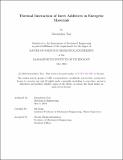Thermal Interaction of Inert Additives in Energetic Materials
Author(s)
Tsai, Gwendolyn
DownloadThesis PDF (16.61Mb)
Advisor
Deng, Sili
Terms of use
Metadata
Show full item recordAbstract
Energetic materials are used for a variety of applications, including airbag deployment and solid rocket fuels, that require high energy density and various energy release rates. The energy release rate, determined by how fast the material burns, is often thought to be proportional to the bulk thermal diffusivity of the material. However, the inclusion of insulating inert particles in energetic materials has shown burning rate enhancement in certain cases. Flame front corrugation that increases the reaction front area observed at micron to sub-millimeter scales was proposed previously to explain the phenomenon. However, a recent simulation study observed a significant temperature gradient within the inert particle, implying that the residence time of the inert particle in the flame front could play a role in the thermal interaction between additives and surrounding energetic materials. In this work, we tested these hypotheses by employing a high-speed microscopic imaging system to quantify the burning rate and flame morphology of Al/CuO nanothermites with various SiO2 particle sizes and mass loading. Additionally, we performed flame propagation simulations to quantify the thermal interactions between the energetic materials and the embedded single inert particle. The experimental results show that the burning rate depends on the particle size as well as mass loading. Specifically, as the SiO2 particle size increases from 100 nm to 100 μm, the burning rate is enhanced by 26% at a mass loading of 7.5%. Further computational studies reveal that flame corrugation may not be the sole factor to alter the burning rate. Non-dimensional analyses show that energy absorption and temperature non-uniformity in inert particles have strong correlations with particle diameter. When the characteristic time of heating the inert particle is shorter than the flame residence time, the inert particle acts as a heat sink, leading to a negative impact on burning rates due to the heat removal from the surrounding energetic materials. Experimental studies reveal that additive particle size has an impact on the nanothermite burn rate. Insight into why this may occur is provided by computational studies of a single particle inclusion, as well as images captured of the burn rate experiments, showing the flame front morphology and particle size effects on heat transfer may play a key role in burn rate alteration by inert additives.
Date issued
2024-05Department
Massachusetts Institute of Technology. Department of Mechanical EngineeringPublisher
Massachusetts Institute of Technology